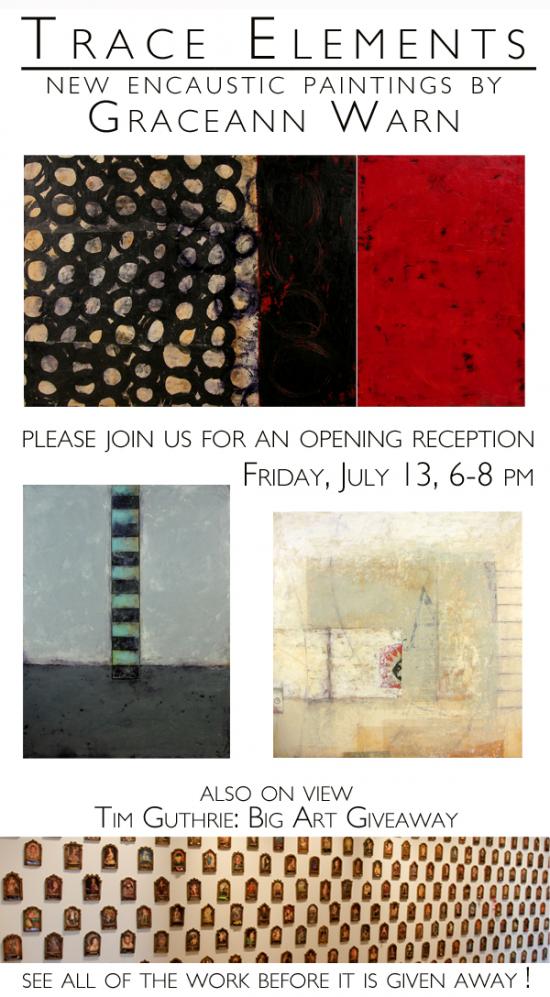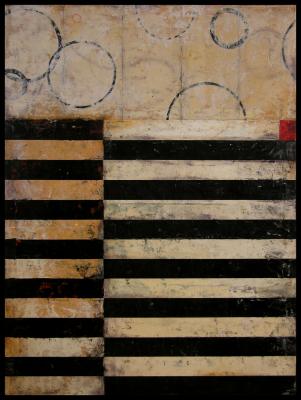Trace Elements
The Encaustic Abstract Paintings of Graceann Warn
by Michael J. Krainak Free Lance Writer in Film and the Visual Arts
Following its June duo exhibit, Left and Right of Center, featuring respectively the representational and figurative paintings of Sunny Gibbons and Tom Rierden, Modern Arts Midtown returns to the unique challenges and rewards of abstract art. Trace Elements offers 15 medium and large format paintings from Michigan artist Graceann Warn in her first solo show in Nebraska.
Although Warn’s educational background consists of urban design and classical archeology, the vestiges of which can be seen in Trace Elements, in 1985 she became a full-time artist known throughout the ‘90s mostly for her assemblages and collages. Examples of this work as well as her current paintings have been exhibited nationally and internationally and are included in the collections of Yale University, several U.S. Embassies and the Pew Charitable Trust, among others.
Warn’s work on display here marks a return to painting, this time in encaustic and oil on reinforced panels. She attributes this new direction to her travels in Oaxaca, Mexico, witnessing local artists working in this painstaking and ancient medium. In an interview with gallerist Laura Moriarty, Warn said she was attracted to this type of process “because I realized that this kind of painting allowed me to work with layers. I could maintain my collage/assemblage but merge into painting fairly seamlessly.” She went on to say that like many other artists—perhaps in particular, abstractionists—she was inspired by old walls, architectural details and crumbling structures. This would explain Warn’s rather poetic artist statement that says eloquently:
The attempt to unearth an object or solve a mystery:
Uncovering/Covering
Leaving a Trace
a Vestige,
a Palimpsest”
It also explains the exhibit’s title by MAM’s director Larry Roots, whose inaugural solo show opened this gallery in Jan. 2012 and bears a visual similarity and sensitivity to Trace Elements. An acknowledged postmodern neo-abstractionist, a style that fits Warn’s paintings particularly well, Roots says that what drew him to her work is a “sublime sense of beauty rather than to something just pretty or pictorial. Her work implies an awe factor or being in awe. It then provokes further investigation as to what that is.”
Warn’s “awe factor” is due in large part to her chosen process and medium, encaustic, whose rich waxy pigments are layered and then scraped away with a final application of Dammar resin. This last step produces a paint film with a higher index of refraction, which accounts in part for the incredible depth of her painted surfaces. It is also why encaustic colors appear luminous in her work whether in simpler pieces such as the place-named “Recoleta” with its vibrant red palette or in more complex paintings as with “Levitation.” In either, layers of ghost images, text and scribblings suggest a history of building up and decay not unlike an ancient manuscript made of parchment or papyrus known as a palimpsest.
As sensual and attractive as Warn’s work is, both she and Roots remind us that their art may remain elusive, which both consider a positive. “If my art endures,” he has said, “it’s because it’s enigmatic. It’s never fully explainable.” And though her “flights of fancy always seem to revolve around some form of revelation,” nevertheless they remain “the attempt” to solve their mystery. This is the nature of abstraction, and the challenge for the viewer is to spend enough face time with her art making it possible to use one’s senses for the purpose of insight rather than mere recognition.
What impresses initially with Warn’s work is her refined aesthetic. In spite of all the surface attention, each piece belies the adage, “beauty is only skin deep.” Instead, the richness of color and texture is of such depth that one is tempted to explore or probe it with more than one’s eyes. This wouldn’t surprise the artist, an admitted synaesthete, that is, one who is capable of connecting or crossing over two senses thus enhancing perception and possible insight.
“I’ll look at a color and taste it, as if colors have flavors or numbers have colors,” Warn says. “When I look at an abstract painting I can taste it or I can hear it. That edge between colors or that connection, that line they make is heartbreaking or it’s joyful. It has an emotion.”
This may seem a stretch for most viewers when confronting or appreciating abstraction but how different is that really from sensing, let alone feeling, the surface of a painting with one’s eyes or being jolted into the past with an unexpected smell? Whatever the taste, smell, emotion or memory Warn’s paintings may evoke, they are never premeditated or prescribed by the artist. Due partly to her process and her love of all things architectural and archeological, the result is a paradox of construction and excavation, a tipping point of discovery and decay. Perhaps that is Warn’s greatest insight; that all creation exists in the moment, on the edge, like flowers at full bloom, unable to go further except for what they in turn nurture and inspire.
In that respect, much of art is a matter of recreation, remembering and re-imagining. Though Warn has immersed herself in painting, certain works here continue her love of collage and assemblage if in subtler ways. This is especially so with “Parione” and “In Barcelona” where layers and various panels that make up the composition seem less accidental and more by design in the former and more calculated or crafted with a decoupage-like effect in the latter. This is not to diminish either piece but only to point out the intelligence and deliberate formality of much of her aesthetic influenced by her past work.
Other paintings such as “Conjecture,” “Night Sail” and “Terra Incognita” look less assembled and more carved out of larger structures as they resemble slabs of ancient blackboards of a higher intellect embedded in brick and stone. Heavy in their surroundings and weighty with the thought processes and musings etched upon and beneath their surfaces, ironically, for all their weathered antiquity, they look remarkably modern.
No single piece in this exhibit looks more “finished’ than the quietly beautiful “Deer Isle 2,” one of several works to reference a place for Warn. In it she has wedged an obelisk sporting a barber pole pattern that may remind many of a lighthouse on any island, the key word being “remind” and not “recognize.” Its rich palette of coral, navy and gray shrouded in a sea-foam green mist serves to heighten mood and mystery and is worthy of anyone’s memory and connection to where sea and land meet.
Lastly, there are the more obscure paintings whose titles of “Interloper,” “One” and “True 2” suggest just how conceptual and detached Warn can be despite how evidently personal her exploration. Though they all share richly dense panels of vibrant and luminescent hues and textures, they take their cue from the aptly titled “Conjecture.” Even such keys or clues as a small panel placed in the side of “Interloper,” a tantalizing dotted line dissecting “One” and a beguiling plumb bob hanging from the top of “True 2” offer only trace elements of what is revealed in her sophisticated abstract art.


